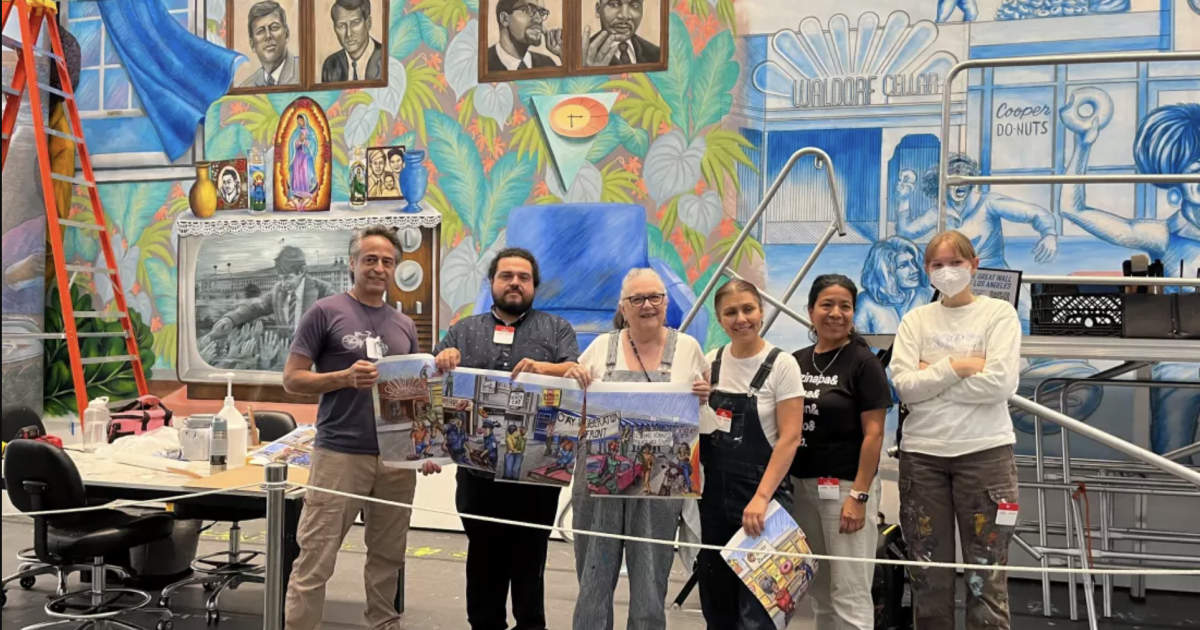Follow LAist.
If you enjoyed this article, you’ll also love our daily morning newsletter, How To LA, bringing you fresh, community-driven stories to keep you up to date on our independent, local news every weekday.
Located along the Los Angeles River, the “Great Wall of Los Angeles” reveals history through paintings depicting people and events from prehistoric times to the 1950s.
More than half a mile of riverside murals that have been painted for nearly 40 years are being updated for the 21st century at the Los Angeles County Museum of Art (LACMA) as a new section is painted over.
The new additions bring what is already one of the largest murals in the world to a total length of one mile.
The original project was born from the artistic vision of Chicana artist and activist Judy Baca, who in the mid-1970s was approached by the Army Corps of Engineers about beautifying the Tujunga Flood Control Channel.
Arriving at the river, Baca reflected on how different neighborhoods in Los Angeles rarely come together, divided by race and nationality. Imagining a space where art could connect the histories and stories of these communities was the catalyst for creating The Great Wall.
“I thought about what would happen if we came together on this endless wall, and I started painting the Great Wall with the idea of creating a narrative mural with a team working across race and class, to help people understand that their history, Black history, Chicano history, Asian history, women’s history, is all our history. To help them see and understand in the image that we are connected,” Baca explained.

Judy Baca stands in front of a mural depicting iconic images from the Los Angeles gay rights movement.
With funding from juvenile justice and anti-poverty programs, Baca began working with dozens of young people, hundreds of artists, and other community members. Over the course of painting the Great Wall, more than 400 collaborators were employed on the project.
She co-founded the Social and Public Art Resource Center and for five years, from 1976 to 1983, used paint to tell the untold stories of Native American, Chicano, Latino, Asian American, African American, Jewish, women and working class communities in the Great Wall of Los Angeles.
Baca hopes the mural’s expansion will continue the work toward improving civil rights for communities whose stories have gone unseen.
“We are visualizing for you the reality and magic of our story. It will create a respect and understanding of our resilience, the resilience of people who have survived incredibly difficult times, and yet managed to contribute and change our society,” Baca said.
Ricardo Mendoza, one of the artists working on the Great Wall expansion, said the new work “deals with other histories and people, people of color, women, ethnic minorities, and it brings all these very important issues back into the past.”
“This is for generations to come to focus their hearts and minds on content that informs and heals,” he continued. “It’s like poetry and metaphor to help people understand a moment in history. It’s like a classroom in that sense.”

The Great Wall extension includes imagery evocative of the 1968 assassination of former U.S. Attorney General Robert F. Kennedy.
When Baca first began painting The Great Wall, he conducted extensive research to ensure his portrayal of history was accurate.
“In 1976, I couldn’t go to the library and check out a book on Black history or Chicano history. I couldn’t check out a book on women’s history. That was just the beginning of the time when we started collecting that kind of material,” she said.
Choosing murals as a way to tell these stories was important to artist Rio Diaz, who also left his mark on the Great Wall.
“This is art for everyone. Not everyone in our community has the freedom and time to come to a museum.”
The mural extension is being painted on a scroll of canvas that will later be installed on the Tujunga Wash wall. Baca and her team will be working at LACMA until July 21, 2024.

